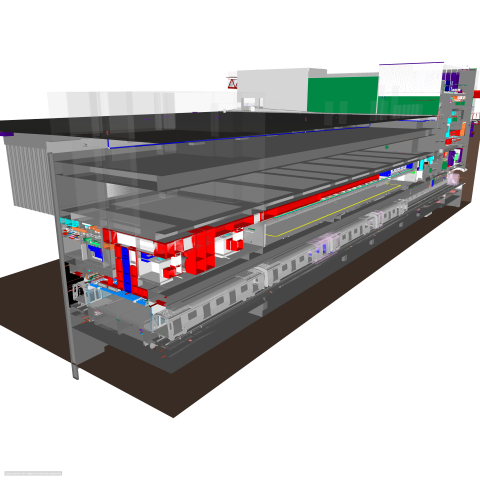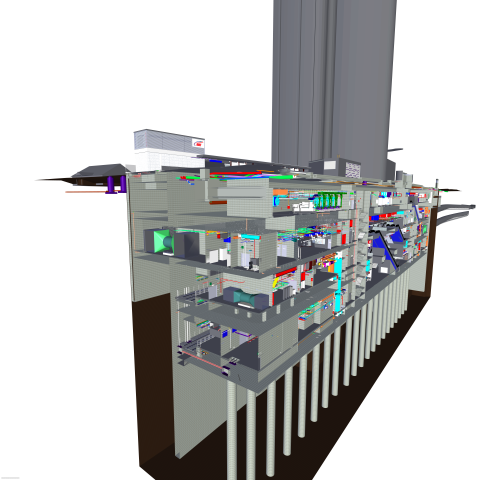The Klang Valley Mass Rapid Transit (KVMRT) is a three-line modern railway system to improve transport and reduce traffic congestion across Greater Kuala Lumpur.
The first MRT line, the Sungai Buloh–Kajang (SBK) Line, was completed in July 2017, while work is currently ongoing for the 52.2-kilometre-long Sungai Buloh–Serdang–Putrajaya (SSP) Line.
The SSP project is managed by two different entities—project owner Mass Rapid Transit Corporation (MRT Corp) as project manager for the underground design and build package; and MMC Gamuda JV as the project delivery partner for the elevated and system works packages.
MRT Corp’s SSP Line Project Division manages the construction of the line’s elevated guideway depots, tunnels and stations, as well as the electrical and mechanical systems required for a fully functional railway system.
Following its experience with the construction of the first line, MRT Corp is pushing for increased productivity and efficiency in the delivery of the SSP line project.
Some of the key issues faced previously were the many on-site changes during construction resulting from design discrepancies or site constraints, delays in design submission due to poor design management, and lack of coordination with the different disciplines to identify clashes in the combined services drawing (CSD).
To better manage these issues, building information modelling (BIM) is used extensively and intentionally from the early stages of the project. In fact, MRT Corp has become the first infrastructure developer in the region to achieve BIM Level 2 accreditation, according to international standards, with the SSP Line.
MRT Corp’s BIM management plan spells out what models are required and their purposes, outlining objectives, deliverable standards and the level of BIM details to be achieved for the project lifecycle—from concept and design to construction and final project phase.
BIM Level 2 involves the use of a common data environment (CDE) database to host all the 3D design models and asset information. In this project, some 2.3 terabytes of information is stored in the cloud-based CDE—comprising 70,000 pages of 3D models, 200,000 drawings and 30,000 documents—shared by more than 700 users from various stakeholders.
The design information is managed via a common process and stringent BIM workflow—with standardised naming convention, information exchange dates, data format and level of detail at different stages of the project—improving collaboration between designers and contractors.
The use of BIM has significantly improved productivity at the design stage and reduced abortive works in the construction phase. For example, about 1,000 conflicts were identified for each MRT site and resolved prior to construction commencing, saving on time and expensive recovery.
This platform also ensures the quick and efficient onboarding of MRT Corp’s engineers, allowing the team to identify potential
issues and design clashes through visualisation and advanced modelling.
Taking a leaf from the Crossrail metro project in the UK, a ‘digital twin’ approach is also applied in the SSP line, where BIM is used to build a digital replica of the project, allowing data to be updated real-time and synced seamlessly across the physical and virtual worlds.
The extensive digital platform used for this project also includes a geographic information system, which contains all related spatial data; reality capture models generated from aerial photography for site progress and incident record; terrestrial laser scanning; mobile apps for
construction inspections and reporting; and asset lifecycle management.
Catalyst for Change
Back in 2015, when MRT Corp had first implemented the BIM Level 2 requirements for its civil contractor and system-wide contractors involved in the underground package, the supply chain in Malaysia was nowhere ready to deliver an infrastructure project of this scale using BIM as a collaboration tool.
There was also a lack of a BIM-competent workforce that could execute the stringent requirements in the Employer Information Requirement (EIR), with some users taking shortcuts or skipping processes along the workflow in the initial stages.
To counter this, MRT Corp initiated a project-centric training centre, BIM in Rail Academy and Training Centre (BIRAC), to promote awareness and upskill the contractors and consultants on the workflow management for successful BIM implementation.
The use of BIM Level 2 constituted a paradigm shift in the construction industry as it has changed how the project team and supply chain work together, compared with conventional projects that only rely on 2D drawing or 3D model submissions.
This digital transformation would not only benefit the asset owner in the long run but also uplift Malaysia’s construction industrial standards, in line with the Construction Industry’s Transformation Programme.
PROJECT DATA
Project Name: MRT Line 2 (SSP) Underground Works
Location: Sungai Buloh, Serdang, Putrajaya, Malaysia
Expected Completion: 2022
Underground tunnels: 13.5 kilometres
Owner/Developer: Mass Rapid Transit Corporation Sdn Bhd (MRT Corp)
Project Management: MRT Corp
BIM & GIS Champion (Design & Technical): Yeap Beow Heng (B.H)
Reference Design Consultant: Arup Jururunding Sdn Bhd
Executive Architect: SAA Architects Pte Ltd
Principal Architect: Yeo Siew Haip
Project Architect: Rustam
Lead Consultant: AECOM Perunding Sdn Bhd
Civil & Structural Engineer: AECOM Perunding Sdn Bhd
MEP Engineer: AECOM Perunding Sdn Bhd
Main Contractor: MMC Gamuda KWMRT (T) Sdn Bhd
Images: SAA Architects; MRT Corp

 Hong Kong
Hong Kong Singapore
Singapore Indonesia
Indonesia Tiếng Việt
Tiếng Việt ประเทศไทย
ประเทศไทย











